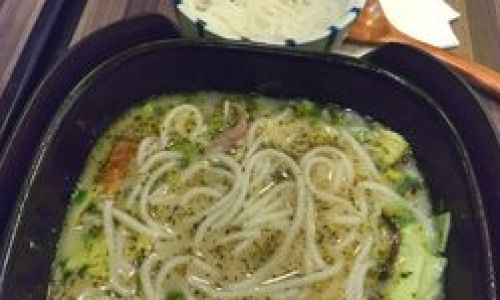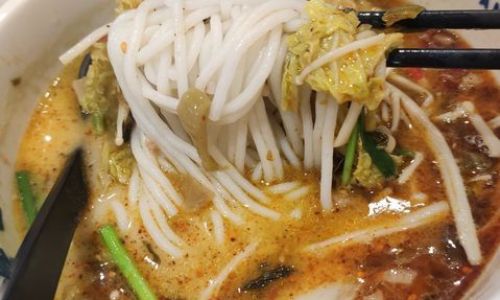Introduction
Axiang Rice Noodles, a beloved dish hailing from China’s Yunnan Province, have captured the hearts and palates of food enthusiasts worldwide. Known for its harmonious blend of aromatic spices, tender rice noodles, and rich broth, this dish is a testament to the region’s culinary diversity. Whether you’re a seasoned home cook or a curious novice, mastering the art of Axiang Rice Noodles allows you to recreate a taste of Yunnan in your own kitchen. This article will guide you through the process, from selecting ingredients to assembling the final bowl, while exploring the cultural significance of this iconic dish.
Key Ingredients
Before diving into the cooking process, it’s essential to gather the right ingredients. Axiang Rice Noodles thrive on balance, combining fresh produce, savory proteins, and fragrant spices. Here’s what you’ll need:
- Rice Noodles: Opt for fresh or dried rice noodles, typically labeled as “Yunnan-style” or “rice stick noodles.” Fresh noodles cook faster and have a softer texture, while dried varieties offer convenience.
- Broth Base: Axiang Rice Noodles rely on a flavorful broth. Use chicken, pork, or vegetable stock as your foundation. For depth, consider adding dried shrimp, smoked ham, or mushrooms.
- Proteins: Traditional recipes often include sliced pork, beef, or chicken. For a vegetarian twist, tofu or mushrooms work beautifully.
- Aromatics and Spices: Garlic, ginger, green onions, and cilantro form the flavor backbone. Sichuan peppercorns, star anise, and cinnamon sticks add warmth, while chili oil or fresh chili peppers provide heat.
- Toppings: Elevate your bowl with fresh herbs (mint, basil), bean sprouts, lime wedges, pickled vegetables, and crushed peanuts.
- Seasonings: Soy sauce, fish sauce, rice vinegar, and a pinch of sugar balance the dish.
Step-by-Step Preparation

Preparing the Broth
The broth is the soul of Axiang Rice Noodles. To achieve its signature complexity:
- Sauté Aromatics: Heat oil in a large pot over medium heat. Add minced garlic, ginger, and sliced shallots. Sauté until golden and fragrant.
- Infuse Spices: Toss in a cinnamon stick, star anise, and a teaspoon of Sichuan peppercorns. Toast lightly to release their oils.
- Build Flavor: Pour in your chosen broth (6–8 cups). Add a tablespoon of tomato paste for richness and a splash of soy sauce for umami. For meat-based broths, include bones or smoked ham hocks for depth.
- Simmer: Reduce heat to low and simmer for 45–60 minutes, skimming off impurities occasionally. Strain the broth and discard solids.
Cooking the Noodles
Properly cooked noodles are tender yet resilient. Follow these steps:
- Soak Dried Noodles: If using dried noodles, soak them in warm water for 20–30 minutes until pliable. Fresh noodles can skip this step.
- Boil: Bring a pot of water to a rolling boil. Add noodles and stir gently to prevent sticking. Cook for 2–4 minutes (fresh) or 5–7 minutes (dried), or until al dente.
- Rinse: Drain and rinse noodles under cold water to halt cooking. Toss with a drizzle of oil to prevent clumping.
Assembling the Bowl
The beauty of Axiang Rice Noodles lies in layering flavors and textures:
- Layer Noodles: Place a generous portion of noodles in the bottom of each bowl.
- Add Proteins: Arrange cooked meat, tofu, or mushrooms over the noodles.
- Ladle Broth: Pour hot broth over the ingredients, ensuring everything is submerged.
- Garnish Generously: Top with fresh herbs, bean sprouts, lime wedges, pickled veggies, and crushed peanuts.
- Drizzle Sauces: Add a splash of chili oil, rice vinegar, and a sprinkle of sugar for acidity and sweetness.
Customization Tips

- Spice Level: Adjust chili oil or fresh peppers to taste. For a mild version, omit chili and use paprika instead.
- Dietary Swaps: Replace meat with crispy fried tofu or enoki mushrooms. Use tamari or coconut aminos for gluten-free options.
- Herb Variations: Experiment with Thai basil, cilantro, or shiso leaves for unique aromatic profiles.
Cultural Significance of Axiang Rice Noodles
Axiang Rice Noodles are more than a meal—they’re a cultural emblem. Originating in Yunnan’s Mon, Bai, and Han Chinese communities, the dish reflects the region’s history as a crossroads of trade and migration. The blend of spices and ingredients mirrors Yunnan’s proximity to Southeast Asia, with hints of Thai, Laotian, and Vietnamese influences.
Traditionally, families gather around steaming bowls of rice noodles during festivals, weddings, and lunar new year celebrations. The act of assembling the bowl together symbolizes unity, with each diner customizing their portion to reflect personal preferences. In modern times, Axiang Rice Noodles have become a symbol of Yunnan’s culinary identity, featured in global food festivals and trendy fusion restaurants.
Health and Nutritional Benefits
Beyond its flavor, Axiang Rice Noodles offer nutritional value:
- Gluten-Free: Rice noodles are naturally gluten-free, making them suitable for celiac diets.
- Protein-Rich: Incorporating lean meats or legumes boosts protein content.
- Vitamin-Packed: Fresh herbs and vegetables provide vitamins A and C, while spices like ginger and garlic offer antioxidants.
- Low in Fat: When prepared with minimal oil, the dish remains relatively low in saturated fats.
Troubleshooting Common Issues

- Mushy Noodles: Overcooking is the culprit. Test noodles a minute before the recommended time.
- Bland Broth: Roast bones or add a splash of fish sauce for umami. Toast spices longer to release their oils.
- Greasy Finish: Use a slotted spoon to skim excess fat from the broth before serving.
Serving Suggestions
Pair Axiang Rice Noodles with:
- Crispy Spring Rolls: For a textural contrast.
- Pickled Tea Leaves: A Yunnan specialty that complements the dish’s acidity.
- Fresh Mango or Papaya: To cleanse the palate between bites.
Conclusion
Crafting Axiang Rice Noodles is a labor of love that rewards patience and precision. Each bowl tells a story—of Yunnan’s lush landscapes, its multicultural heritage, and the joy of sharing a meal with loved ones. Whether you’re slurping noodles on a chilly evening or impressing guests at a dinner party, this dish invites you to savor the essence of Yunnan. Experiment, adapt, and most importantly, relish the process. After all, the best recipes are those made with heart.
Final Tip: For an authentic touch, serve your Axiang Rice Noodles in a clay pot to retain heat and enhance the broth’s aroma. Buon appetito—or as they say in Yunnan, “Chī hǎo!” (Enjoy your meal!).





0 comments